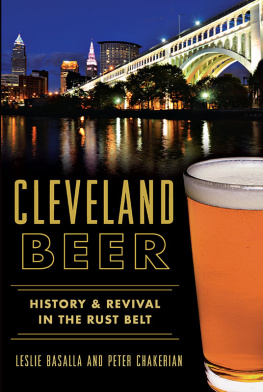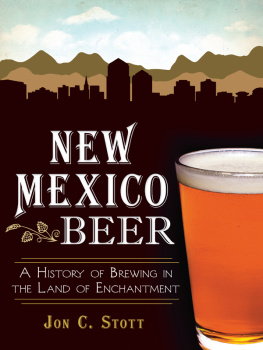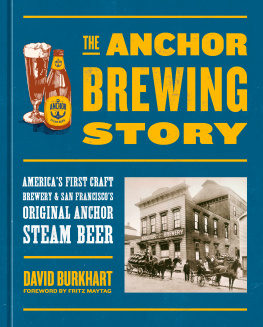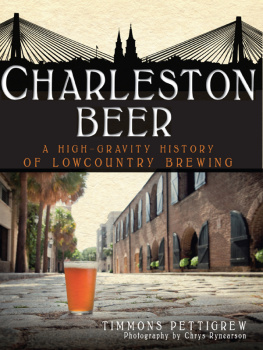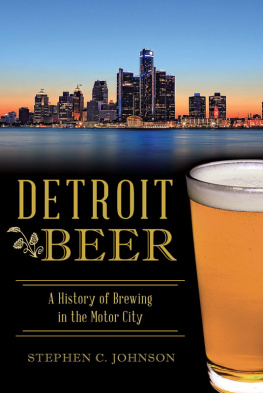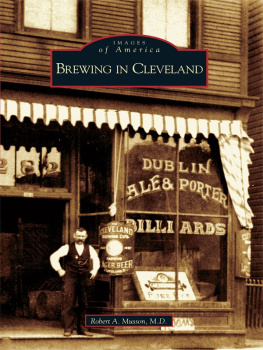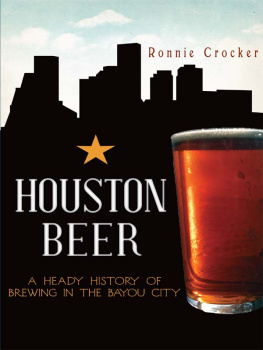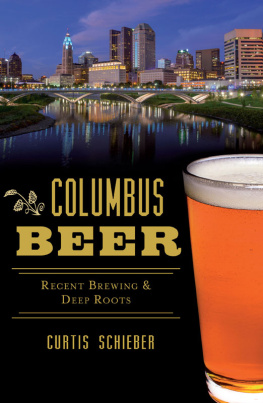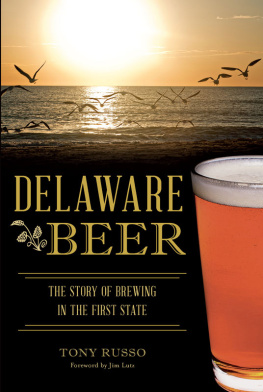


Published by American Palate
A Division of The History Press
Charleston, SC
www.historypress.net
Copyright 2015 by Leslie Basalla and Peter Chakerian
All rights reserved
First published 2015
e-book edition 2015
ISBN 978.1.62585.570.1
Library of Congress Control Number: 2015948354
print edition ISBN 978.1.46711.779.1
Notice: The information in this book is true and complete to the best of our knowledge. It is offered without guarantee on the part of the author or The History Press. The author and The History Press disclaim all liability in connection with the use of this book.
All rights reserved. No part of this book may be reproduced or transmitted in any form whatsoever without prior written permission from the publisher except in the case of brief quotations embodied in critical articles and reviews.
CONTENTS
FOREWORD
Beeryou could say it was what Cleveland was founded on in the late 1700s. And its again beer that, some two hundred years later, is fueling the renaissance of our fair city. Just as those early settlers brewed up a great new home on the shores of Lake Erie, modern day re-settlers are using beer and brewing to rebuild Clevelands neighborhoods in this post-industrial frontier city.
What was shall be again.
Clevelands renaissance has created vibrant, dense, walkable neighborhoods with locally brewed craft beer flowing everywhere, and the historic Ohio City neighborhood on the near west side is the epicenter. In 1988, Ohio City saw the opening of the states first local craft brewery since Prohibition, Great Lakes Brewing Company. Nearly twenty years later, the neighborhood is home to dozens of restaurants, beer bars, wine bars, cafs, galleries and more. Leading the charge was a succession of craft breweries starting in 2011 with Market Garden Brewery, then Nano Brew Cleveland, Platform Brewery, Brick and Barrel Brewery and Winery and soon Hansa Brewery and Forest City Brewery.
The wider city and suburbs have gained their share of acclaimed breweries, with many serving as hubs for their own neighborhoods, and there seems to be no end in sight.
Clevelanders are a fun-loving and broad-shouldered people, and they have had an affinity for local beer and the conviviality it brings to gatherings of family and friends since the city was founded.
And the beery best is yet to come
Cheers and beers,
SAM McNULTY
Owner, Market Garden Brewery and Nano Brew Cleveland
ACKNOWlEDGEMENTS
There are a great many people whose contributions and support made this book possible. We cannot begin to express our gratitude enough.
Leslie Basalla would like to thank:
Brian P. McCafferty for tolerating all the time I put into the research and writing of this booktime I could have been spending with himand for and always being willing to listen when I needed encouragement.
My parents, Thomas and Mary Beth Basalla; my brothers, Greg and Nate; and my entire family.
Bob and Shelle Campbell, the former owners of the Cleveland Brew Bus, for bringing me into the business and inadvertently dropping the opportunity to write this book into my lap.
Carl Miller, for his inestimable scholarship on Cleveland brewing history and incredible generosity in sharing images from his collection.
Jenna Fournier for shooting a lovely author photo.
Bonnie Flinner and Prosperity Social Club for photos of their excellent collection of local breweriana.
The helpful staff at Cleveland Public Library.
John Bowen, for being the first person, way back when, to believe in me as a writer.
All of my service industry friends, past and present.
And last but absolutely not least, all of the incredibly devoted and passionate people working at Clevelands craft breweries, especially Paul Benner, Shaun Yasaki, Ralph Sgro, Bill Reilly and Ken Wagenhouser of Platform Beer Company; Janet and Jamie Hall, Tom Gray, Michael Zoscak and Ted Lipovan of Fat Heads; Matt and Kathy Chappel of Indigo Imp; Sam McNulty and the whole crew at Market Garden and Nano; Luke Purcell of Great Lakes; Karl Spiesman and Darrell Mikols of Brick and Barrel; and Jason Kallicragas, Andy Knecht and Ken Budney Jr. of the BottleHouse.
Peter Chakerian would like to thank:
Layne Anderson, the Beckwiths, Laura Watilo Blake, Marc Bona, Kelsey Brubaker, Susan Carroll, the Chakerians (all of them), Bruce Chamberlin, Cleveland Landmarks Press (Greg Deegan, Jim Toman, John Yasenosky), the Cook-Provost clan, Joe Crea, Brittyn DeWerth, Joe Dubbs, Eric and Cynthia Eakin, David Farkas, Michael Gallucci, Glenn Gamboa, David Giffels, the Giffords (all of them), Gray & Company, Kristen Hampshire, Annette and Joe Jones, Al Kaston, Glenn Kenny, Mandy Kizcek, Chuck Klosterman, Cheryl Kushner, Kenny and Tracy Larson and kids, Steven Liss, Janet Macoska, Eleanore McLaughlin, Chris McVetta, Vern Morrison, Kay Morrow, Thomas Mulready and Carol Hunt, John L. Nagy, Michael Norman, Eric Olsen, Susan Petrone, Karen Robinson, Connie Schultz, Jane Scott, Paula Schleis, Joseph Sheppa, Jim Szatkowski and Retta Kalcik, Claudia J. Taller, Sarah Toman, Douglas Trattner, Shelley Underwood and family, Carlo Wolff and Karen Sandstrom and Chuck Yarborough.
Special thanks to the Cleveland State University Digital Production Unit/Cleveland Memory Project and all the fine, helpful folks at CSUs Michael Schwartz Library. None of this would have been possible without you.
INTRODUCTION
While I was in New Connecticut, I laid out a town on the bank of Lake Erie, which was called by my name, and I believe the child is now born that may live to see the place as large as Old Windham.
Moses Cleaveland, 1796
When the city of Clevelands founder arrived atop a high bluff at the mouth of the Cuyahoga River in July 1796, he could not possibly have conceived of the future size and prosperity of the village his surveyors were about to map out. His optimistic prediction that the town might surpass Windham, Connecticut, in population within a generation indeed came true. By 1837, Cleveland was a major commercial hub of the Great Lakes and boasted a population of 9,000 residents, quite a few more than Windhams 2,700.
By 1920, Cleveland was the fifth-largest city in the United States, boosted by a robust manufacturing industry. While steel was the citys best-known product, one of its best loved, especially by its own residents, was beer. Starting around the 1840s when an influx of German immigrants brought their taste for lager to Lake Eries shores, the city has had a venerable tradition of brewing, and much the like the town itself, Clevelands beer industry grew immensely with time.
Of course, since those heady days, the citys commercial landscape has changed considerably. Prohibition struck a nearly devastating blow to local brewing, just as the Great Depression shook the citys economy. The World War II years and immediate postwar period brought another heyday to Cleveland, both industrially and in the realm of brewing. But by the 1960s and 70s, as heavy manufacturing largely collapsed around the Great Lakes, earning the region the moniker of the Rust Belt, brewing followed suit. Outcompeted by national brands and consolidated into nonexistence, Clevelands legendary old breweries disappeared one by one, until, at last, in 1984, there were none.
Next page
